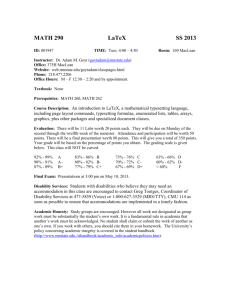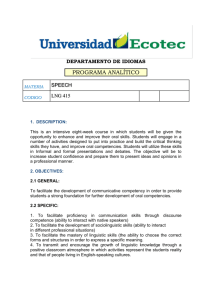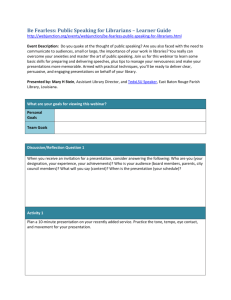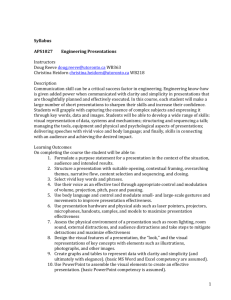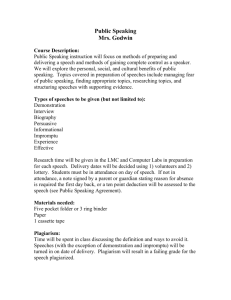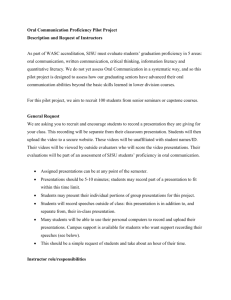CMUN 101- Public Speaking and Critical Thinking* Spring Semester
advertisement
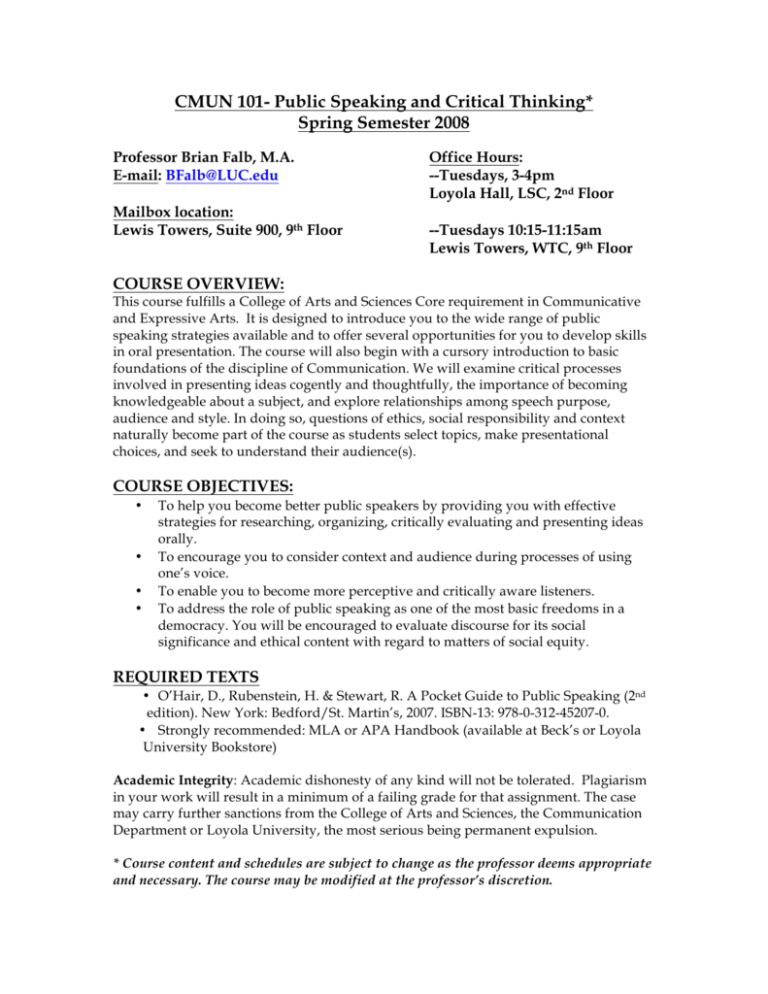
CMUN 101- Public Speaking and Critical Thinking* Spring Semester 2008 Professor Brian Falb, M.A. E-mail: BFalb@LUC.edu Mailbox location: Lewis Towers, Suite 900, 9th Floor Office Hours: --Tuesdays, 3-4pm Loyola Hall, LSC, 2nd Floor --Tuesdays 10:15-11:15am Lewis Towers, WTC, 9th Floor COURSE OVERVIEW: This course fulfills a College of Arts and Sciences Core requirement in Communicative and Expressive Arts. It is designed to introduce you to the wide range of public speaking strategies available and to offer several opportunities for you to develop skills in oral presentation. The course will also begin with a cursory introduction to basic foundations of the discipline of Communication. We will examine critical processes involved in presenting ideas cogently and thoughtfully, the importance of becoming knowledgeable about a subject, and explore relationships among speech purpose, audience and style. In doing so, questions of ethics, social responsibility and context naturally become part of the course as students select topics, make presentational choices, and seek to understand their audience(s). COURSE OBJECTIVES: • • • • To help you become better public speakers by providing you with effective strategies for researching, organizing, critically evaluating and presenting ideas orally. To encourage you to consider context and audience during processes of using one’s voice. To enable you to become more perceptive and critically aware listeners. To address the role of public speaking as one of the most basic freedoms in a democracy. You will be encouraged to evaluate discourse for its social significance and ethical content with regard to matters of social equity. REQUIRED TEXTS • O’Hair, D., Rubenstein, H. & Stewart, R. A Pocket Guide to Public Speaking (2nd edition). New York: Bedford/St. Martin’s, 2007. ISBN-13: 978-0-312-45207-0. • Strongly recommended: MLA or APA Handbook (available at Beck’s or Loyola University Bookstore) Academic Integrity: Academic dishonesty of any kind will not be tolerated. Plagiarism in your work will result in a minimum of a failing grade for that assignment. The case may carry further sanctions from the College of Arts and Sciences, the Communication Department or Loyola University, the most serious being permanent expulsion. * Course content and schedules are subject to change as the professor deems appropriate and necessary. The course may be modified at the professor’s discretion. Plagiarism is to “appropriate passages and ideas from [the ideas or writings of another] and use them as one’s own” (The American Heritage Dictionary, Boston, MA: Houghton Mifflin, p. 946). This definition extends to non-written work—e.g. speaking. Plagiarism is a serious violation of academic honesty and results in severe consequences ranging from a grade of zero for the assignment in question to dismissal from the university. Avoid turning in work that could be interpreted as plagiarism or academically dishonest. If you have questions about proper source referencing, see someone at the Tutoring Center in the Sullivan Center, Suite 260, (773) 508-7714. Please also note the Communication Department uses new online technology to uncover plagiarism. Online resources are also available through the Loyola libraries Web site. Be especially careful choosing online sources as well as citing them. This is an academic community; being uninformed or naive is not an acceptable excuse for not properly referencing your sources. If you are in doubt about something, please come speak with me! Students requiring classroom accommodation for disabilities must provide written documentation from the appropriate university official regarding the specific disability during the first week of class. The professor will work with the student to arrange necessary accommodations. It is the responsibility of the student to make the professor aware of any disabilities as soon as possible so all accommodations can be made. EVALUATION: In general, oral presentations will be evaluated on the basis of significance, thoroughness, organization, presentational style (includes language use), and audience interest in presentation and topic. Outlines are due on the FIRST day of a new speech; everyone must turn in their outline regardless of whether they present that day. Presentations must be timed ahead of time and students are expected to adhere to the requirements. A one-letter grade penalty will be assessed for non-compliance with time requirements. Speeches involving research that fail to properly cite source materials will receive FAILING grades. This includes ORAL citation of sources when speeches are executed and WRITTEN notations on a reference page and in the TEXT of your outline. Your speech grade will be based equally on your research and outline and your presentation. PARTICIPATION: You are expected to participate in class in several important ways: 1) as a prepared oral presenter, 2) as an active and responsive audience member, 3) as a contributor to class discussions. Be timely: turn in work on time, show up on time. If you will be more than 5 minutes late, do not come into class! Be engaged: attentive to discussions, directions, course materials, assignments, in-class activities, peer presentations Be here: you are expected to attend every class. For this course to work as it should, your contributions to in-class activities are of paramount importance. Therefore, mini-assignments (5-10 points) related to lecture/discussion will contribute to your participation grade (20% of overall course work). These assignments cannot be made up nor turned in late. If you miss a day, you will be unable to complete the work for that day and you will miss points for that assignment. The instructor also reserves the right to adjust overall course grades on the basis of observations of your in-class presence, level of engagement, and the timeliness with which you complete assignments. Participation will be the greatest determining factor in assessing borderline grades. If you are always there, engaged and a contributing member of the group, then you will probably receive an above average or superior grade (A or B) in participation. If you are usually in class (e.g. 2 or fewer absences), demonstrate little active engagement with discussions, and hand in assignments on time, you will probably receive an average grade (C) in participation. If you are rarely in class (3 or more absences), appear disengaged from the class, and turn assignments in late or not at all, you will probably get a failing participation grade (and maybe more importantly, a failing grade for the course). If it is your habit to show up only on the dates your speeches are due, you can expect a failing participation grade. Late Work: No make-ups are available except in the most extreme circumstances. All presentations will be executed in class on the assigned date. Speakers will be chosen randomly so as to be fair to everyone presenting. You must be prepared to speak on the first day- no exceptions! If you are not prepared when randomly chosen, your grade will drop 2 full grades (i.e. an “A” speech will automatically get a C if the student is not prepared on the day chosen). Being prepared is especially important in a Public Speaking class because if you do not meet your obligations, everyone is affected. Selfevaluations are due the class period following the presentation. No late self-evaluations will be accepted. Evaluations: Students are expected to critically and honestly reflect on speech performances and to identify areas for improvement. This part of course work will be evaluated on the basis of a student’s ability to authentically reflect on their own expressive skills, level of effort and in-class execution of prepared materials. These evaluations are to be used as tools for self-assessment and improvement. The selfevaluations will be due the class period after the speech is executed. Every student will be asked to evaluate others’ speeches and those evaluations will be factored into the participation grade. COURSE REQUIREMENTS 10% Class participation and quizzes; regular attendance is required. 10% Self-evaluations (Due every class period after speech is executed). 10% Extemporaneous speech (5-7 minutes) 15% Cultural artifact presentation (6-8 minutes) 15% Group project (10-20 minutes) 15% Non-standard presentation (10-15 minutes) 25% Public issues presentation (15-25 minutes) Grading Scale: A 94-100 B 84-86 C 74-76 D 64-66 ABCD- 90-93 80-83 70-73 60-63 B+ C+ D+ F 87-89 77-79 67-69 Below 60 Copyrighted Class Materials: Class notes, lectures, presentations, assignments, etc. are the copyrighted materials of the professor. The copying and sale of any such materials will subject the involved parties to the provisions of the Federal Copyright Act. If you have any questions or concerns throughout the semester, please let me know! SEMESTER SCHEDULE Jan 15 Jan 17 Jan 22 Jan 24 Jan 29 Jan 31 Feb 5 Feb 7 Feb 12 Feb 14 Feb 19 Feb 21 Feb 26 Feb 28 Mar 4/6 Mar 11 Mar 13 Mar 18 Mar 20 Mar 25 Mar 27 Apr 1 Apr 3 Apr 8 Apr 10 Apr 15 Apr 17 Apr 22 Apr 24 Apr 29 Welcome, introductions, syllabus review READ: Ch. 1-6 READ: Ch. 7-11 Extemporaneous Speeches Extemporaneous Speeches READ: Ch. 12-16 READ: Ch. 17-22 Cultural Artifact speech (ALL outlines due) Cultural Artifact speech Cultural Artifact speech In-class group work, practice group speeches Group projects (ALL outlines due) Group projects Group projects Spring Break (no class) READ: Ch. 23-25 Non-standard presentation (ALL outlines due) Non-standard presentation Non-standard presentation Non-standard presentation READ: Ch. 26-30 READ: 31-35 READ: TBD Workshop on public issues presentations Public issues presentations (ALL outlines due) Public issues presentations Public issues presentations Public issues presentations Public issues presentations FINAL EXAM PERIOD (11:30a.m.-12:45p.m.) (if needed for final speeches) Explanation of speeches and presentations 1. Extemporaneous Speech Assignment Prepare a 5-7 minute narrative to be delivered extemporaneously in class. It should be a story about one of the following topics: An experience that changed my life A time spent with someone important to me The biggest mistake I ever made My most embarrassing moment (that you can share!) An extemporaneous delivery should be practiced and prepared, but not necessarily memorized. You may use up to 3 note cards. Generally, you should memorize your first and last sentence. Refer to assigned readings and class discussions for assistance. **You must adhere to the time limits. A one-letter grade reduction will be made for more than 1 minute over or under time. 2. Cultural Artifact Presentation § Topic § Choose a cultural artifact/idea about which you can provide new insight for this class. Your topic might involve an actual object, an event, a concept, a process, a place, or an artwork. § In choosing your topic, focus on contextualizing it within some culture or subculture. Explain the basis upon which it is significant to a group of people with shared beliefs/experiences. Keep time limits in mind when making your selection. Explain how it is significant to your actual audience (us). § These presentations are designed to inform your audience about some kind of cultural symbolism—something people may know little or nothing about or about which people often have misconceptions. In other words, it is fine to choose artifacts that are taken for granted but there is some aspect of something familiar that you would like to bring to light for your audience. Support § Personal testimony, anecdotes, “inherited wisdom” § At least one outside research source must be used § At least one source of traditional academic research must be used (e.g. book, journal article) § One visual aid is required Evaluation: (presentation and documents) § Full sentence outline must be turned in the first day speeches are due § Audience analysis, clarity, interest, arrangement, support, delivery § Adherence to time limits (6-8 minutes) Structure: § 6-8 minutes (1 minute leeway); anything longer or shorter will receive a oneletter grade penalty § Pattern of arrangement must be evident; attention should be paid to opening and closing as well as internal development § Notes are acceptable; use of notes is subject to evaluation (e.g. full size paper is distracting; note-cards are usually better) § No lectern may be used; you may stand or move around purposefully. No sitting down. 3. Group project • Topic: • Choose a speech that has been given sometime in the past and that you can play for the class (from a YouTube site, video, etc.). It should be significant enough in length that you can analyze and interpret what the speaker is trying to say and to do, at least 5 minutes in length. • Your presentation should show the speech to the class and should systematically analyze the techniques and approaches used by that particular speaker. It should give an background and context to the speech and any historical or factual information so the entire class has an appropriate context for the speech. • The group should identify strengths and weaknesses of the text as well as the presentation, the purpose of the speech, any discernable techniques or structure, etc. The focus should be on the intention of the speech as well as the quality with which that intent is reached. • Support: • Use the textbook to evaluate and to critically analyze the text and presentation of the speech chosen • Outside research could be done to support your claims; critically analyze the facts and figures the speaker is presenting. This could include expert testimony from written sources or additional examples, facts/statistics • At least three outside sources should be cited in your speech. All should be credible and relevant. Wikipedia is not a source! Be careful using online sources. • Evaluation • Full sentence outline must be turned in on day speeches begin • Audience analysis, clarity, interest, arrangement, support, delivery • Adherence to time limits (10-20 minutes) • Special emphasis on ethical and effective audience appeal • Structure • 10-20 minutes with 2 minute leeway; group members should speak roughly the same amount of time • Careful execution and arrangement of speech given as well as a logical structure to the evaluation of the speech chosen • Effective use of notecards; no “read” script 4. Non-standard speech Topic: Choose any topic you wish: keep in mind that you have an obligation to engage the interest of this audience and you must accomplish your speaking goal within the allotted time frame. Delivery: The special purpose of this speech is to explore nonstandard ways of effectively making your point in a public presentation. Therefore, you may do almost anything to deliver your “speech” except stand and talk in a standard speech format. For example, you could present your message as storytelling, poetry, music, drama, in pictures, as a puppet show, as a comedy routine, as a museum installation, as a protest, as a news report, as management training, as a tour, as a talk show, or as a teach-in. A traditional euro-american mode of public address employs linear logic (intro, body, conclusion), and is spoken earnestly in one’s own persona. This course acknowledges the value of this approach but also asks students to explore alternative ways of effective communication. The content and form of the presentation are up to individual students (within the parameters established by the instructor). However, students need to convey a clear purpose in their presentation, and therefore be able to explain how that modality best achieves that purpose. In short, the topic, messages and format should be congruent. Support: Whatever is appropriate to the topic and message (look at support for previous assignments) Evaluation: Audience analysis, clarity of purpose, interest, coherence, support, delivery. Structure: 10-12 minutes 5. Public Issues Presentation Topic: • Choose a topic that involves a challenge in convincing the audience to accept your idea, interpretation, suggestion or plan of action regarding an existing current event. • The topic may be of local or global import • Your presentation angle must be as localized as possible. On what basis should your audience care about this issue? What can your classmates do about it now? • Not everyone will care about your topic nor agree with your position. How can you anticipate the questions or concerns you might need to address with regard to its importance to your audience? Your goal is to invite everyone to change their mind and/or be moved to action or consider new ideas. • Support: • Personal observation, especially based on your own experiences • Informal interviews with others, especially relevant experts and/or community members • Expert testimony from written sources • Anecdotes, examples, facts/statistics • At least three outside sources should be cited in your speech. All should be credible and relevant. Wikipedia is not a source! Be careful using online sources. • Evaluation • Full sentence outline must be turned in on day speeches begin • Audience analysis, clarity, interest, arrangement, support, delivery • Adherence to time limits (15-25 minutes) • Special emphasis on ethical and effective audience appeal • Structure • 15-25 minutes with 2 minute leeway • Careful execution and arrangement of speech according to motivated sequence (attention, need, satisfaction, visualization, call to action) must be evident. • Effective use of notecards; no “read” script
